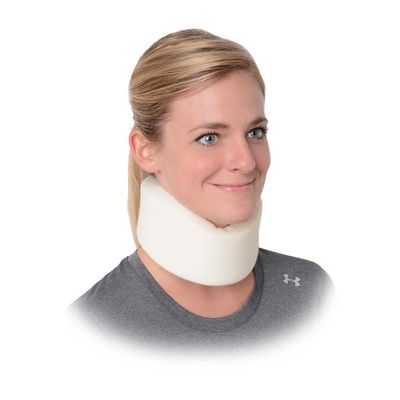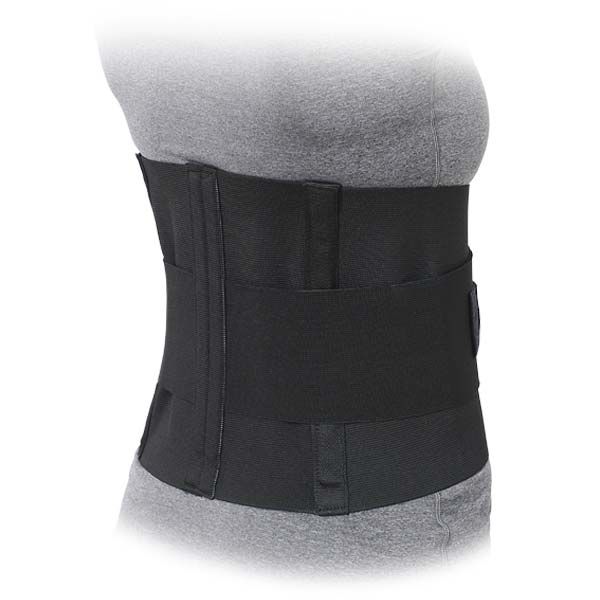
Lumbar Sacral = Back Support W/ Side Pulls
A back support with side pulls is a type of orthopedic brace designed to provide stability, compression, and support to the lower back, particularly in cases of lower back pain, injury, or strain. The addition of side pulls allows for adjustable compression and increased support, helping to alleviate pain and promote proper posture.
Key Features of a Back Support with Side Pulls
Adjustable Side Pulls
- Side pulls are adjustable straps or laces that allow users to tighten or loosen the brace as needed. This feature provides customizable compression and support to the lower back, enhancing comfort and effectiveness.
- The side pulls allow for easy adjustments throughout the day, accommodating changes in comfort level or activity.
Lumbar Support
- The brace is designed to target the lumbar region (lower back), providing support to the spine and surrounding muscles. This can help reduce stress on the back and prevent further injury.
Compression
- The compression provided by the brace helps reduce swelling and inflammation, which can lead to pain relief. Compression also promotes better posture and can improve muscle engagement in the lower back.
Breathable Material
- Many back supports with side pulls are made from breathable, moisture-wicking materials to ensure comfort during extended use. This helps reduce heat buildup and prevents skin irritation.
Ergonomic Design
- Designed to fit the natural curves of the back, the support is contoured to provide a snug and comfortable fit. The side pulls enable adjustments to fit a variety of body shapes and sizes.
Velcro or Hook-and-Loop Fastening
- The brace is usually secured with Velcro or hook-and-loop fasteners, allowing users to easily adjust the tightness for optimal support.
Uses of a Back Support with Side Pulls
Lower Back Pain Relief
- Ideal for people suffering from lower back pain due to muscle strain, overuse, or conditions like sciatica or herniated discs. The side pulls provide extra support to stabilize the lower back and alleviate pain.
Posture Improvement
- Helps correct poor posture by providing lumbar support and encouraging a more upright position. This can be particularly helpful for individuals who spend long hours sitting or standing in improper positions.
Injury Prevention
- Used by athletes, manual laborers, or individuals who perform heavy lifting to prevent lower back injuries. The brace adds extra stability to the spine and reduces the risk of strain or injury.
Post-Surgical Support
- Provides stability and reduces strain on the lower back following surgery or injury, promoting a faster recovery and preventing reinjury.
Chronic Back Conditions
- Beneficial for individuals with chronic back conditions such as degenerative disc disease, osteoarthritis, or lumbar stenosis. The adjustable side pulls allow for consistent support based on the level of discomfort.
Benefits of Back Support with Side Pulls
- Customizable Compression: The adjustable side pulls enable the user to tighten or loosen the brace, providing the right amount of compression based on activity level or pain.
- Improved Stability: By stabilizing the lower back and promoting proper posture, the brace helps reduce strain on the spine and surrounding muscles.
- Pain Relief: Compression and support can alleviate pain caused by injury, muscle strain, or chronic back conditions.
- Enhanced Mobility: Many users find that the brace allows them to continue daily activities with less pain, while still supporting their back.
How to Use a Back Support with Side Pulls
- Position the Brace: Center the back support over your lower back (lumbar region), ensuring it is sitting comfortably.
- Fasten the Brace: Secure the front closure (typically Velcro) around your abdomen. The brace should fit snugly but not too tight to restrict breathing or movement.
- Adjust Side Pulls: Tighten or loosen the side pulls as needed to customize the level of compression and support. Make sure the brace feels secure and provides adequate support without causing discomfort.
- Wear During Activity: Use the back support during activities that may strain your lower back, such as lifting, bending, or prolonged sitting/standing. You can also wear it during exercise if advised by a healthcare provider.
- Do Not Overuse: While a back support can be helpful for pain relief and injury prevention, it’s important not to become overly reliant on the brace. Overuse can lead to weakened back muscles. Gradually work on strengthening your back through physical therapy or exercises.
Care and Maintenance
- Follow the manufacturer’s instructions for cleaning and maintaining the back support. Most are hand-washable or machine-washable in a gentle cycle.
- Ensure that the brace is fully dry before wearing it again to prevent skin irritation or damage to the materials.
A back support with side pulls can be an effective tool for managing back pain, supporting posture, and preventing injury. It’s ideal for those with lower back issues who need adjustable support for varying levels of activity and comfort.
ORDER NUMBER: 501-W, 503-W, 505-W, 507-W, 507-W, 508-W, 509-W, 510-W, 511-W, 512-W
501-B, 503-B, 505-B, 507-B, 508-B, 509-B, 510-B, 511-B, 512-B
SIZE: X-Small thru 5X Large (see sizing chart to the left)
PRODUCT HIGHLIGHTS:
• Form-fitting 10" all-elastic with double pull side panels for additional support
• High quality Velcro™ closure for durability
• Four flexible stays in back panel for excellent support
INDICATIONS:
Ideal for providing support and compression for strains and sprains of the lower back.
SUGGESTED HCPC: L0625
Categories: Cervical, Spine & Abdominal


Table of Contents
Shoulder and Elbow Brace
Shoulder and elbow braces are designed to provide stability, support, and relief from pain associated with injuries or chronic conditions affecting these joints. These braces are often used to aid recovery, improve mobility, and prevent further injury.
Shoulder Brace:
A shoulder brace typically provides compression and stabilization to the shoulder joint, helping to reduce pain and inflammation while promoting proper posture. Shoulder braces are often used for:
- Rotator cuff injuries: To protect and support the shoulder after a tear or strain.
- Shoulder dislocations: To stabilize the joint and prevent further dislocations.
- Post-surgical recovery: Assisting with immobilization and gradual rehabilitation.
- Chronic instability: Preventing overuse injuries and reducing the risk of reinjury during physical activity.
Features of a Shoulder Brace:
- Compression: Helps to reduce swelling and pain.
- Adjustable Straps: Allow for customized support and positioning.
- Breathable Materials: Keep the shoulder area cool while providing support.
- Immobilization: Some shoulder braces restrict movement for more severe injuries, while others allow for controlled range of motion.
Elbow Brace:
An elbow brace is commonly used to support the elbow joint, reduce strain, and alleviate pain. They are often used for conditions such as:
- Tennis Elbow (Lateral Epicondylitis): A common overuse injury where the brace applies pressure to the forearm muscles, reducing strain on the elbow tendon.
- Golfer’s Elbow (Medial Epicondylitis): Similar to tennis elbow, but affects the inner side of the elbow.
- Elbow sprains and strains: Supporting the joint during recovery to prevent further damage.
- Post-surgery: Stabilizing the elbow after surgical procedures to promote healing.
Features of an Elbow Brace:
- Targeted Compression: Helps to relieve pain and inflammation in specific areas.
- Adjustability: Allows users to control the level of compression and support.
- Lightweight and Breathable: Ensures comfort during prolonged use.
- Range of Motion Control: Some braces have hinges to control how much the elbow can bend.
Both shoulder and elbow braces are important tools for athletes, manual laborers, or individuals recovering from injuries or surgery. They can be used for rehabilitation, pain management, and injury prevention.
Shoulder and Elbow Pain
Common Causes of Shoulder Pain:
- Rotator Cuff Injuries: This is one of the most common sources of shoulder pain. It occurs due to strain or tears in the muscles and tendons around the shoulder joint.
- Frozen Shoulder (Adhesive Capsulitis): This is characterized by stiffness and reduced mobility in the shoulder joint.
- Tendinitis or Bursitis: Inflammation of the tendons or bursae can cause sharp, localized pain in the shoulder.
- Arthritis: Wear and tear in the shoulder joint can lead to osteoarthritis, causing chronic pain and stiffness.
- Dislocation: When the upper arm bone is forced out of the shoulder socket, it can cause intense pain and instability.
Common Causes of Elbow Pain:
- Tennis Elbow (Lateral Epicondylitis): This occurs due to overuse of the forearm muscles, leading to pain on the outside of the elbow.
- Golfer’s Elbow (Medial Epicondylitis): This condition causes pain on the inside of the elbow, often due to repetitive stress.
- Olecranon Bursitis: Inflammation of the bursa at the tip of the elbow can cause swelling and pain.
- Cubital Tunnel Syndrome: Compression of the ulnar nerve near the elbow can lead to pain, numbness, and tingling in the forearm and hand.
- Elbow Arthritis: Like the shoulder, the elbow can suffer from arthritis, leading to joint stiffness and discomfort.
Treatment and Management:
- Rest and Activity Modification: Reducing activities that aggravate the pain can help prevent further damage.
- Physical Therapy: Strengthening and stretching exercises for the shoulder and elbow muscles can relieve pain and restore function.
- Pain Relief: Nonsteroidal anti-inflammatory drugs (NSAIDs) or ice packs can reduce inflammation and pain.
- Bracing: Supportive braces, such as a tennis elbow brace or a shoulder sling, can help offload the affected joints and promote healing.
- Surgery: In severe cases, such as rotator cuff tears or advanced arthritis, surgery may be necessary.
If shoulder or elbow pain persists, it is important to consult a healthcare professional for an accurate diagnosis and treatment plan.

